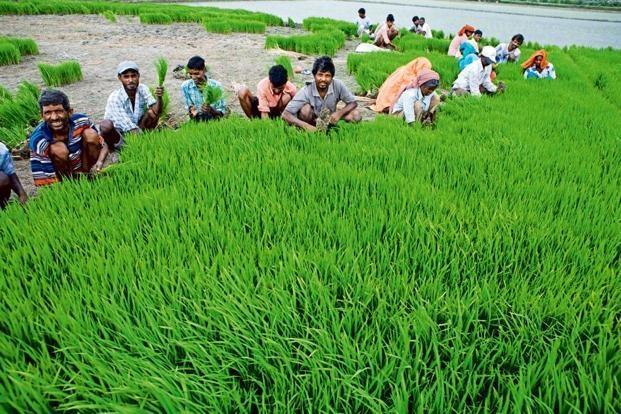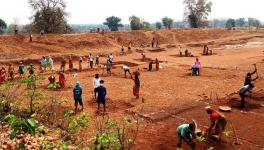Green Revolution And the Collapse Of the Developmental State

Image Courtesy: Livemint
The first part of this series has documented the partial success of land-reforms in creating a class of rich peasants and nudging sections of landlords to undertake cultivation, instead of living off rents extracted from tenants as they had previously done. This had initiated a process towards overcoming the “in-built depressor” - a situation which discouraged landlords from investing in agriculture as the wealth they could extract in form of rents and usury was higher than the profits they could reap on investments in cultivation.
The support for land-reforms to break the landlords’ stranglehold on India’s agriculture soon after independence had come not only from the peasantry, but also from many quarters of the capitalist class, who had believed that a small-peasant economy, as a result of better incentives, is more productive than a pre-capitalist ground-rent based agrarian economy.
The primary concern that had made them to be sympathetically disposed towards land-reforms was not the improvement in living standards of small peasants, but rather “increasing marketable surplus” in order to feed the towns and provide raw materials for industry. However, when other technical, apolitical methods of raising surpluses from large-farms - without disturbing the class-structure - were proposed, their support for land-reforms dwindled, and with it dwindled the State’s commitment to pursue such radical measures.
Green revolution: a decisive overcoming of the agrarian depressor
Based on recommendations in the Report on India’s Food Crisis and Steps to meet it (1959), prepared by American experts sponsored by Ford Foundation, the government introduced Intensive Agricultural District Programme, known popularly as Package Programme, whose emphasis was, in John Mellor’s words, on “measures for immediate increase in agricultural production rather than measures for improving the general context for development or immediate welfare.”
The main undertakings of this programme was provision of subsidized inputs such as fertilizers, pesticides, high-yielding variety of seeds, and importantly, provision of cheap credit to economically viable farmers who held the promise of producing a large marketable surplus. During the first decade since the introduction of this programme (in 1960s), fertilizer consumption rose by nine times, number of electric and diesel pumpsets and tractors went up by five, and tubewells by 38 times, while the amount of area under high-yielding varieties of seeds saw an eleven-fold increase, according to Hamza Alvi.
In the meantime, investment in agriculture had become attractive in the backdrop of rising food-grain prices and the improvement in terms of trade of agriculture vis-a-vis manufacturing, particularly in the period from 1963-75: owing partly to the expansion of domestic market resulting from the purchasing-power vested in a huge portion of unskilled labourers employed under various infrastructural projects undertaken by the government and partly due to the setting of floor prices on food grains by the way of state procurements.
However, for those large landlords who were still extracting surplus through rent rather than profit, price-rise alone was not a sufficient inducement to undertake direct cultivation because it was matched with an increase, even if not immediate, in the rents paid by tenants for cultivating the lands they owned.
Therefore, in a situation where the landlords’ monopoly over land was not entirely dismantled, what was required to overcome the built-in depressor or the rent barrier was technical advancements which sharply increase the yield per unit area, and this, Utsa Patnaik wrote, was “precisely the character of the Borlaug fertilizer-fed hybrid seed, which has been successfully introduced in wheat and rice production under controlled irrigation.” The yield doubled, even tripled, if the soil was fed with recommended amounts of water and fertilizers on time. This allowed for a “decisive overcoming of the rent barrier”, which had held back investments in agriculture for reasons explained in the previous part of this series.
Thus, with the built-in depressor deactivated, foodgrain production soared rapidly, and India, for the first time since independence, became self-sufficient in food. From being a net-importer of food grain since 1951, India became self-sufficient by 1975, before accumulating, in the next ten years, almost 30 million tonnes of grain in the government’s reserve stock. This achievement was what is popularly known as the ‘Green revolution’, epitomising an alternative to the ‘Red revolution’.
Success of Green revolution was accompanied by increasing unemployment and widening inequality
These accomplishments of the Green revolution were not, however, free from contradictions. A comparison of data from the Third All-India Rural Labour Enquiries conducted in 1963-64 and the Fourth conducted in 1974-75 shows that, in this period, the average total number of days of wage-employment per worker dropped from 235 to 210 for men, from 153 to 143 for women and from 202 to 171 for children. While mechanization might have explained this rise in unemployment, ideally, such mechanization must also cause a rise in the wages for those that remain employed on account of productivity gains. Showing only money wage-rates, the official data suggests a “deceptively impressive rise” in wages.
However, accounting for the rise in prices by applying consumer price index of 1974-75, Utsa Patnaik calculates that the real-wages had actually declined for men by a third during this period, and had nearly halved for women and children. Making leeway for the argument that 1974-75 was a year with record-levels of inflation and application of that year’s index might therefore produce exaggerated results, she shows further that even on applying the consumer price index of 1975-76, when the price-rise was to a certain extent moderated, a 25% reduction in real wages for men, and 15% for women, can still be observed. This decline of real wages, in a situation where the previous wages barely provided for subsistence, forced an enormous portion of the workforce to take loans for basic-survival, which doubled the real-indebtedness in the eleven years from 1963-64 to 1974-75, giving a strong impetus for increase in debt-bondage.
While the wage-labourers employed in agriculture suffered a decrease in employment and wages, the benefits reaped by landholding peasants was highly uneven, for two main reasons. Firstly, achievement of the potentially high yields from the hybrid seeds required controlled irrigation and low atmospheric humidity without long periods of cloud cover. The states of Uttar Pradesh, Punjab, Haryana, Gujarat and Rajasthan, which have the required climate-soil conditions, achieved enormous leaps in yields, amounting to 62% of the total increase of 32 million tonnes in food-grain production from 1973-74 to 1982-83.
On the other hand, the high-rainfall areas and high-humidity regions along the coastlines, which had until then dominated food production, drastically lost its share of total foodgrains produced. Total proportion of rice production from the traditional paddy-growing areas like Bihar, West Bengal, Tamil Nadu, Kerala and Karnataka declined from 45.4% to 34.8% in this period. This produced a spatially uneven development, increasing regional economic disparities.
Secondly, although the biochemical inputs offered through the programme were promised to be scale neutral - assuring that it will therefore not have the effect of increasing further the already high economic-disparity between owners of large swaths of land and the small-peasants - this effect nonetheless was inevitable because the inputs were not resource neutral. Scale neutrality implies that the economic viability of this technology (unlike tractors, combine harvesters and some types of irrigation) is not dependent on having a certain minimum size of operation or economy of scale. “However, as the experience of Green Revolution in India shows, resource neutrality (a socio-economic assumption) is not the same as scale neutrality (a technical assumption)” Henry Bernstein argued.
Controlled irrigation, timely and adequate supply of fertilizers, and affordability of seasonal labour during harvest seasons in case of wet-rice production, are all absolutely vital to reap the potential gains from hybrid seeds. Since one’s capacity to obtain these essentials is not independent of one’s economic and political power, the benefits reaped by wealthy farmers owning large areas of land, by far outstripped any gains the small peasants could achieve. Moreover, the benefits of productivity-gains achieved to whatever extent by small peasants was more than off-set by the rising prices, which immiserated the small peasants while at the same time benefiting large farmers.
The pattern of distribution of operational farm-holdings at the time reveals the reason for the accelerating effect price-rise in food grains has on the process of class-differentiation. National Agricultural Census of 1980-81 indicates that 74.5% of the farm-holding households were each in command of small areas of land of 2ha or less, while only 2.4% owned 10ha or more. On the other hand, the total area under the command of this minority of 2.4% amounted to 22.8% of all farm holdings, while 26.3% of farm-holdings was owned by all the 74.5% put together.
Due to such disparity in distribution of landholding, the top one-eight of the rural population, Utsa Patnaik estimated in 1986, generated 70-75% of the market-supply of foodgrains. “Rising food prices primarily benefit this small minority monopolising lion’s share of the commodity surplus and give them super-profits.” Smallholders, on the other hand, who sell on the market only a small portion of their produce and often depend on incomes from subsidiary occupations, “figure mainly as buyers of agricultural produce and high prices erode their real incomes,” Alvi pointed out by quoting S. C Gupta.
Thus, “there was a general pauperisation of large sections of the rural population in the midst of an enormous increase in the prosperity of a few big landholders.” This pauperization of the peasants whose economy was not viable anymore, led not only to high indebtedness, but also an increase in distress-selling of land, allowing the large-landowners to accumulate even more land, increasing further the already high concentration of land-ownership.
Here it must be noted that in spite of deepening class-differentiation, which simultaneously increased land-concentration and landlessness, and in spite of declining wage-employment and real-incomes, the enormous increase in food-production was not inconsequential to nutritional levels of the population. Through the Public Distribution System (PDS) instituted in 1960s, the government had established a system of subsidies through which it “moved food from surplus areas of Green Revolution belt to deficit areas, and sold food grains at a price low enough to ensure adequate off take,” Kathy Walker pointed out. Although not free from shortcomings, the PDS system, an article in Analytical Monthly Review argued, was “at base a success and achieved a substantial increase in per capita consumption of calories.”
However, the cost of maintaining the productivity gains and cushioning, through welfare provisions, the ripple-effect of negative consequences generated by this kind of agricultural growth in a system of landlord capitalism - that has developed in a fundamentally unreformed agrarian structure - was soon going to become unaffordable.
The Developmental State finally collapsed under the weight of its own contradictions
Had the land-reforms succeeded in breaking the land-monopoly and facilitating a more equal distribution of this vital resource among the peasantry, the capitalist mode of agriculture that would have followed would have had a fundamentally different system of incentives in the economy. In such a reformed structure, there would exist neither a huge population of land-hungry cultivators, desperate enough to pay exploitative rates of rent to access land for survival, nor a minority that holds monopoly control over the access to land. As a result, the absolute ground rent would be significantly lower. This factor, in combination with the fact each peasant can only hold a relatively smaller area of land, is likely to leave the cultivator with only one avenue for profiting in agriculture: investment in direct cultivation.
In other words, the built-in depressor would not exist anymore, with the rent-barrier effectively dismantled. Under such circumstances, small and gradual increments in productivity would serve as a sufficient incentive for the peasant capitalists to maintain an increasing level of investment in agriculture.
When, on the other hand, a capitalist mode of agriculture develops as a result of technological change which overcomes the rent-barrier through productivity gains, sustaining investments in agriculture under such circumstances, requires a constant maintenance of profit margins in cultivation above the returns the landlord can get by renting his land and using the rent money for non-productive activities such as usury. To meet this requirement, Utsa Patnaik argued, a “continuous stimuli by way of successive rounds of feasible technical change which can raise surplus per unit area by discrete quanta” is necessary.
And when the potential for productivity gains had begun to ebb by the late 80s, after nearly exhausting “the easy avenues of output expansion and the raising of the yield base, further output expansion in future (was).. bound to encounter more severe constraints by the way of a higher requirement of investment for a given increment of output. Irrigation investment in particular cannot be undertaken by landlords unless a further round of yield raising technical change becomes feasible.”
At this point, when further investments by the state was necessary to maintain the growth in agricultural output and productivity, the government’s ability to spend was being severely constrained in the late 80s, as decades of inflationary spending had begun to take its toll. Michel Kalesci had warned back in early 1950s that expenditure on the implementation of the India’s Five year plans was bound to be inflationary, because the class-nature of the state made credit-financing more convenient politically than taxing the wealthy landowning and capitalist class.
The long-term consequence of the refusal of Indian state to radically alter its class-nature and its unwillingness to tax sufficiently was the mounting gross-fiscal deficit, which rose from 9% of the GDP in 1980-81 to 12.7% in 1990-91. This deficit had to be met by borrowing, which raised the government’s foreign debt from $20.5 billion to $72 billion during this period, making India the world’s third largest debtor. When this fragile economy was hit by the external shock of rising oil-prices because of the gulf war in mid 80s, “India’s oil import bill swelled, exports slumped, credit dried up and investors took their money out,” the Telegraph Bureau reported. By 1991, when India’s foreign exchange reserves had come down to $1.2 billion - barely enough for two weeks of imports - the possibility of defaulting on external balance of payments obligations had become eminent. India desperately needed a loan.
This period, when the collapse of Soviet Union was being theorized as the failure of socialism itself, was witnessing an ideological shift towards neoliberalism, to which, it was argued, there can be no alternative. The Bretton Woods institutions - World Bank and IMF - were on the forefront, peddling this ideology to governments across the world. It was in these times that India was forced to borrow a loan of $2.2 billion from IMF, capitulating its economic sovereignty in the process by accepting the conditions of structural adjustments, requiring the state to minimize public expenditure, open its markets to foreign goods and encourage privatization.
Thus it was that the developmental state - which had facilitated a shift towards capitalist mode of agricultural production in the agrarian economy without altering the land-monopoly pattern that had emerged from, and was sustained by, centuries of extra-economic coercion under a pre-capitalist mode of production - collapsed under the weight of its own contradictions. And it was on the ruins of this developmental state, that the neoliberal Indian state emerged in the 1990s, quickly reversing the food-security gains made in four decades post independence.
Get the latest reports & analysis with people's perspective on Protests, movements & deep analytical videos, discussions of the current affairs in your Telegram app. Subscribe to NewsClick's Telegram channel & get Real-Time updates on stories, as they get published on our website.























